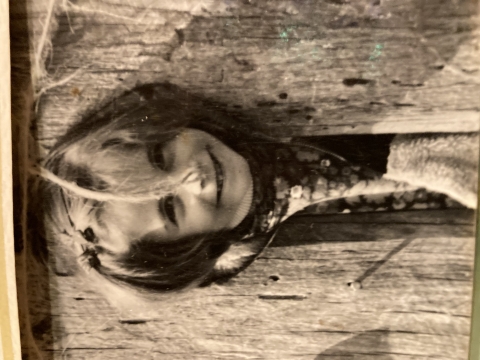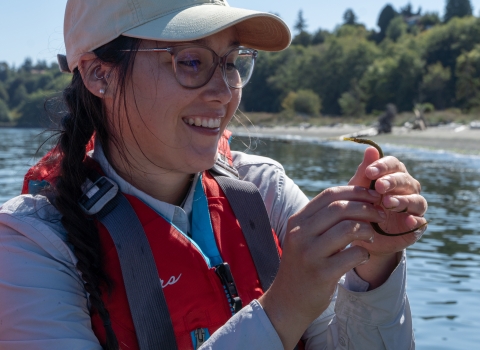Our farm was one of those “back to the land” farms, a short-lived trend, popular in the 1970s. Three acres and a barn that backed up onto hundreds of acres of woods. I would return from the forest, dirty, with a pocket full of rocks and acorns. I would sneak caterpillars, crickets, or even a toad into my bedroom. Once discovered, these creatures would be promptly evicted by my parents. I took all of this for granted, the fireflies, the frogs, the piney woods. It was all I knew. I was well acquainted with the natural world, but I did not have a “Sense of Wonder” in any meaningful way. My first memorable moment of wonder, magic and mystery didn’t happen until after I had moved away from the farm.
That moment came at a small coastal camp, Briarwood. I remember my shock, surprise, and absolute wonder when we waded into the ocean with a large net. We let the net sink to the bottom and dragged it to shore. I could not believe the weight of the net, heavy with crabs, fish, snails, seaweed — all these creatures I had no idea existed right there, out of my sight. That experience lay tucked away as I made my way through middle, then high school.
If I had to pinpoint what finally beckoned to me to wildlife, it was when I was working for a veterinarian, and someone brought an injured Black Duck into the office. Seeing that bird up close made me curious. How the heck did that bird get here and what was wrong with it? It was then that I began to enroll in wildlife classes and, eventually, graduate school.
With a master’s degree in hand, a 1984 VW Jetta, and very little practical wildlife experience, I set off on my adventure. I traveled, from temporary wildlife job to job, novel experience to novel experience. From Hawaiian monk seals, to the boreal forest and the flat lands of the Outer Banks of North Carolina, I soaked it all in. I listened to the gray wolf howl in the working forests of Canada, paddled in beautiful, yet contaminated wetlands tucked amongst the mountains of Idaho, walked the vast agricultural bread basket where massive black bear and red wolf roamed, lived on a storybook Pacific atoll with albatross nesting amongst plastic debris. I saw firsthand how humans had impacted even the most remote corners of the earth. It was jarring to have this extreme sense of wonder, at exactly the same time and place as a sense of disbelief that things were not as they seemed.
Through the years my sense of wonder cemented to a sense of a heavy responsibility and discomfort. It was as if I had a window open to a home into which only I could see. What would happen to the creatures that lived there? A famous quote from Leopold’s A Sand County Almanac rattled around in my mind, pulling at me for some time.
One of the penalties of an ecological education is that one lives alone in a world of wounds. Much of the damage inflicted on land is quite invisible to laymen. An ecologist must either harden his shell and make believe that the consequences of science are none of his business, or he must be the doctor who sees the marks of death in a community that believes itself well and does not want to be told otherwise.
Despite the challenges facing wildlife conservation being far more extreme than I had anticipated, I thought I could neither “harden my shell” nor view my fellow humans as uncaring when I had seen again and again, that most people cared very deeply about wildlife.
Refuge biologists have a tendency to stay put, and not move from job to job. They stay captivated with their Refuge, unravelling the mysteries of the land, trying to solve thorny conservation problems — it is not a speedy process. The challenges facing our wildlife and Refuges have grown more extreme, and I admit there are days I think I did not sign up to bear witness to this; however, those days are rare. Now, I consider the words of our Refuge’s namesake, Rachel Carson, and I consider them carefully:
“Wonder and humility are wholesome emotions, and they do not exist side by side with a lust for destruction.”
― Rachel Carson, Speech accepting the John Burroughs Medal, 1952
The key to conservation lies not in the animals themselves, but with people. I started to take every chance I could to lead people to that hidden house, to encourage them to look inside the window and connect in a personal way with wildlife. Did I see a group of scouts in the parking lot of the Refuge? I would pop open the bird house to show them the chickadee nest inside. Was there a person that looked at us with curiosity as we waded out of the salt marsh salt marsh
Salt marshes are found in tidal areas near the coast, where freshwater mixes with saltwater.
Learn more about salt marsh in our muddy hip boots?
I would tell them about the saltmarsh sparrow, struggling to raise its young before water levels rose to flood its nest. Fortunately, I was not alone; our talented staff worked hard to share our sense of wonder. We roamed the beaches, showing people tiny plover chicks, only days old, darting to the shore to feed. We encouraged people to listen, really listen, to the bird song in the morning, to notice the migrating monarchs clinging to seaside goldenrod in the fall.
Using all of the tools at hand, we invited our neighbors to peek inside that window, either virtually, or in real life. Communities must experience the sense of wonder of the world; people cannot properly conserve what they don’t know about. Part of our Mission at Rachel Carson NWR is to take that sense of wonder and amazement and turn it into decisions to conserve our natural world.
This natural world, and all the sense of wonder within, requires a balance between wonderment and knowledge, between human desires and the environment, between our generation and the generations yet to arrive. I am looking forward to the time when I can hand over my binoculars to our Refuge visitors and invite them to take a close look at the sea ducks, the plovers, the monarchs and the sparrows and invite you into the world of wonder. The days where I see people and communities working together to conserve wildlife and wild places are much more common than not, and for that, we are grateful.









